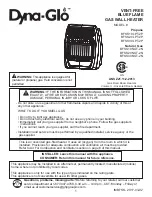
Safety
24.10.2018
6 / 20
Copyright
2018 by: WATERKOTTE GmbH Subject to changes.
Ensure that particularly during installation and maintenance work, as well
as when placing out of operation, groundwater pollutants such as:
Grease, oils, solvent-containing cleaning fluids, etc. do not contaminate
the ground or enter into the sewer system!
These substances must be collected, stored, transported, and disposed
of in suitable containers.
1.2.4
Modifications and repairs
For safety reasons, no unauthorised modifications shall be performed on
the domestic water heater.
Thus, all intended modifications are subject to written approval by
WATERKOTTE.
Use only original WATERKOTTE spare parts.
Original parts are specifically designed for your domestic water heater.
Externally procured parts provide no guarantee that they are designed and
manufactured in compliance with relevant usage and safety requirements.
Parts and special equipment not delivered by WATERKOTTE are not
approved for use on the domestic water heater.
1.3
Hazards
Observe the following points to avoid life-threatening injuries and damages
to the domestic water heater during operation:
Risk of death by electric shock!
Do not use water or other liquids to clean the system!
Keep all electrical supply units locked at all times!
Any work on the electrical equipment of the domestic water heater shall
only be performed by professional electricians!
Risk of burns!
During operation, surface temperatures (heat exchanger) can exceed 60 °C.
Do not remove housing cover during operation!
Allow domestic water heater to cool down before removing cover.
Risk of Scalding!
Risk of scalding due to high flow temperatures!
By design high flow temperatures are possible during operation of the de-
vice:
To limit the temperature we recommend the installation of a thermostat-
controlled mixing valve at the exit of the hot water tank.
Electrostatic charge!
Electronic components can be damaged by electrostatic processes.
Ground yourself before touching electronic components.
Risk of total loss!
The unit may only be switched on after the hydraulic circuits are completely
filled and vented, and all electrical connections are properly established.
















































